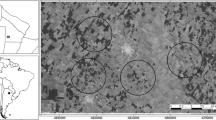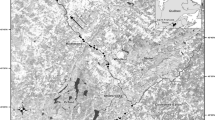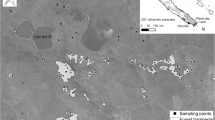The micro-landform unit system offers an effective way of analyzing vegetation–geomorphology relationships at a 10-m scale in areas such as the hilly regions of Japan. We analyzed relationships between micro-landforms and tree population parameters over a 9-year interval to elucidate the influence of geomorphic processes on vegetation dynamics. A 2.16-ha permanent plot was established in a temperate mixed forest. Each 5 m × 5 m quadrat within this plot was classified according to six types of micro-landform units: (i) crest slope (CS); (ii) upper sideslope (US); (iii) head hollow (HH); (iv) lower sideslope (LS); (v) foot slope (FS); and (vi) river bed (RB). All living trees larger than 10 cm in diameter at breast height (d.b.h.) were identified, mapped and marked in 1989 and resurveyed in 1998. Almost all of the 23 common tree species persisted in their own core habitats (i.e. the micro-landforms) between the two surveys. The species distribution in both surveys showed that the six micro-landforms could be combined into two larger groups: upper and lower hillslope areas. The upper hillslope area had higher tree densities and larger basal areas than the lower hillslope area. It is possible that these differences result from the longer lifespans of trees on the upper hillslope area rather than from differences in mortality and recruitment rates. In addition, the different ways in which trees die in the different micro-landform units may affect the regeneration process in hilly regions through different gap formation. The effects of different geomorphic processes are reflected in the lifespans of the trees and may result in different forest structure and dynamics among micro-landform units.
Similar content being viewed by others
References
Ashton P. M. S., Gunatilleke C. V. S. & Gunatilleke I. A. U. N. (1995) Seedling survival and growth of four Shorea species in a Sri Lankan rainforest. Journal of Tropical Ecology 11: 263–279.
Basnet K. (1992) Effect of topography on the pattern of trees in Tobonuco (Dacryodes excelsa) dominated rainforest of Puerto Rico. Biotropica 24: 31–42.
Beatty S. W. (1984) Influence of microtopography and canopy species on spatial patterns of forest understory plants. Ecology 65: 1406–1419.
Bell D. T. (1980) Gradient trends in the streamside forest of central Illinois. Bulletin of the Torrey Botanical Club 107: 172–180.
Bellingham P. J., Kohyama T. & Aiba S. (1996) The effects of a typhoon on Japanese warm temperate rainforests. Ecological Research 11: 229–247.
Brokaw N. V. L. (1985) Treefalls, regrowth, and community structure in tropical forests. In: The Ecology of Natural Disturbance and Patch Dynamics (eds S. T. A. Pickett & P. S. White) pp. 53–69. Academic Press, San Diego.
Craig A. E., Walker K. F. & Boulton A. J. (1991) Effects of edaphic factors and flood frequency on the abundance of Lignum (Muehlenbeckia florulenta Meissner) (Polygonaceae) on the River Murray floodplain, South Australia. Australian Journal of Botany 39: 431–443.
Drury W. H. & Nisbet C. T. (1971) Inter-relations between developmental models in geomorphology, plant ecology, and animal ecology. General Systems 16: 57–68.
Gale N. & Barfod A. S. (1999) Canopy tree mode of death in a western Ecuadorian rain forest. Journal of Tropical Ecology 15: 415–436.
Gale N. & Hall P. (2001) Factors determining the modes of tree death in three Bornean rain forests. Journal of Vegetation Science 12: 337–346.
Hack J. T. & Goodlett J. C. (1960) Geomorphology and forest ecology of a mountain region in the Central Appalachians. Geological Survey Professional Paper 347: 1–66.
Hall P., Ashton P. S., Condit R., Manokaran N. & Hubbell S. P. (1998) Signal and noise in sampling tropical forest structure and dynamics. In: Forest Diversity Research, Monitoring and Modeling: Conceptual Background and Old World Case Studies (Man and the Biosphere Series V. 20) (eds F. Dallmeier & J. A. Comiskey) pp. 63–77. UNESCO, Paris.
Hara M., Hirata K., Fujiwara M. & Oono K. (1996) Vegetation structure in relation to micro-landform in an evergreen broad-leaved forest on Amami Ohshima Island, south-west Japan. Ecological Research 11: 325–337.
Harrison E. A., McIntyre B. M. & Dueser R. D. (1989) Community dynamics and topographic controls on forest pattern in Shenandoah National Park, Virginia. Bulletin of the Torrey Botanical Club 116: 1–14.
Hirabuki Y. (1990) Description of community structure and ecological characteristics of component woody species in a temperate mixed forest, northeast Japan. Bulletin of Miyagi University of Education, Part II Natural Sciences and Education 25: 23–43 (in Japanese with English summary).
Hupp C. R. (1983) Seedling establishment on a landslide site. Castanea 48: 89–98.
Kikuchi T. & Miura O. (1991) Differentiation in vegetation related to micro-scale landforms with special reference to the lower sideslope. Ecological Review 22: 61–70.
Kikuchi T. & Miura O. (1993) Vegetation patterns in relation to micro-scale landforms in hilly land regions. Vegetatio 106: 147–154.
Krasny M. E. & Whitmore M. C. (1992) Gradual and sudden forest canopy gaps in Allegheny northern hardwood forests. Canadian Journal of Forest Research 22: 139–143.
Kurosawa T., Tateishi Y. & Kajita T. (1995) Flora of Aobayama, wild vascular plants in the botanical garden of Tohoku University, Sendai, Japan. Ecological Review 23: 111–170.
Langenheim J. H. (1956) Plant succession on a subalpine earthflow in Colorado. Ecology 37: 301–317.
Lyford W. H. & MacLean D. W. (1966) Mound and pit microrelief in relation to soil disturbance and tree disturbance in New Brunswick, Canada. Harvard Forest Paper 15: 1–18.
Masaki T., Tanaka H., Tanouchi H., Sakai T. & Nakashizuka T. (1999) Structure, dynamics and disturbance regime of temperate broad-leaved forests in Japan. Journal of Vegetation Science 10: 805–814.
Miles D. W. R. & Swanson F. J. (1986) Vegetation composition on recent landslides in the Cascade Mountains of western Oregon. Canadian Journal of Forest Research 16: 739–744.
Miura O. & Kikuchi T. (1978) Preliminary investigation on vegetation and micro-landforms at valley head in the hills. In: Papers on Plant Ecology to the Memory of Dr Kuniji Yoshioka (eds Society of Plant Ecology) pp. 466–477. Society of Plant Ecology, Tohoku (in Japanese).
Nagamatsu D. & Miura O. (1997) Soil disturbance regime in relation to micro-scale landform and its effects on vegetation structure in a hilly area in Japan. Plant Ecology 133: 191–200.
Nagamatsu D., Seiwa K. & Sakai A. (2002) Seedling establishment of deciduous trees in various topographic positions. Journal of Vegetation Science 13: 35–44.
Naito T. & Mochida Y. (1990) Vegetation of the site of Sendai Castle and surrounding area. In: ‘Sendaijoushi-No-Shizen’ (eds M. Kato, H. Nakagawa & H. Ohashi) pp. 137–148. Sendai-shi-kyouiku-iinkai (The Board of Education, Sendai City), Sendai (in Japanese).
Nakamura F., Yajima T. & Kikuchi S. (1997) Structure and composition of riparian forests with special reference to geomorphic site conditions along the Tokachi River, northern Japan. Plant Ecology 133: 209–219.
Oliver C. D. & Larson B. C. (1990) Forest Stand Dynamics. McGraw-Hill, New York.
Pineda F. D., Nicolas J. P., Pou A. & Galiano E. F. (1981) Ecological succession in oligotrophic pastures of central Spain. Vegetatio 44: 165–176.
Potvin M. A. (1993) Establishment of native grass seedlings along a topographic/moisture gradient in the Nebraska sandhills. American Midland Naturalist 130: 248–261.
Putz F. E. (1983) Treefall pits and mounds, buried seeds, and the importance of soil disturbance to pioneer trees on Barro Collorado Island, Panama. Ecology 64: 1069–1074.
Putz F. E., Coley P. D., Lu K., Montalvo A. & Aiello A. (1983) Uprooting and snapping of trees: structural determinants and ecological consequences. Canadian Journal of Forest Research 13: 1011–1020.
Robertson P. A., MacKenzie M. D. & Elliott L. F. (1984) Gradient analysis and classification of the woody vegetation for four sites in southern Illinois and adjacent Missouri. Vegetatio 58: 87–104.
Sakai A. & Ohsawa M. (1993) Vegetation pattern and microtopography on a landslide scar of Mt Kiyosumi, central Japan. Ecological Research 8: 47–56.
Sakai A. & Ohsawa M. (1994) Topographical pattern of the forest vegetation on a river basin in a warm-temperate hilly region, central Japan. Ecological Research 9: 269–280.
Satake Y., Hara H., Watari S. & Tominari T. (1989) Wild Flowers of Japan Woody Plants I, II. Heibonsha, Tokyo (in Japanese).
Shaukat S. S. & Qadir S. A. (1971) Multivariate analysis of the vegetation of calcarious hills around Karachi. I. An indirect gradient analysis. Vegetatio 23: 235–253.
Shimada K. (1994) Topographical distribution of five pioneer tree species and significance of their tree forms in natural forests on Mt Takao, central Japan. Japanese Journal of Ecology 44: 293–304 (in Japanese with English summary).
Shimokawa E. (1984) A natural recovery process of vegetation on landslide scars and landslide periodicity in forested drainage basins. In: Symposium on Effects of Forest Land Use on Erosion and Slope Stability (eds C. L. O’Loughlin & A. J. Pierce) pp. 99–107. East-West Center, University of Hawaii, Honolulu.
Stewart G. H., Basher L. R., Burrows L. E., Runkle J. R., Hall G. M. J. & Jackson R. J. (1993) Beech-hardwood forest composition, landforms, and soil relationships, north Westland, New Zealand. Vegetatio 106: 111–125.
Sugawara K. (1969) Ecological studies in the Botanical Garden of the Tohoku University I. Present state of the vegetation. Ecological Review 17: 209–216.
Tamura T. (1969) A series of micro-landform units composing valley-heads in the hills near Sendai. The Science Reports of Tohoku University, 7th Series (Geography) 19: 111–127.
Tamura T. (1980) Multiscale landform classification study in the hills of Japan. I. Device of a multiscale landform classification system. The Science Reports of Tohoku University, 7th Series (Geography) 30: 1–19.
Tamura T. (1981) Multiscale landform classification study in the hills of Japan. II. Application of the multiscale landform classification system to pure geomorphological studies of the hills of Japan. The Science Reports of Tohoku University, 7th Series (Geography) 31: 85–154.
Tamura T. (1987) Landform-soil features of the humid temperate hills. Pedologist 31: 29–40 (in Japanese).
Tanaka N. (1985) Patchy structure of a temperate mixed forest and topography in the Chichibu mountains, Japan. Japanese Journal of Ecology 35: 153–167.
Thomas R. L. & Anderson R. C. (1993) Influence of topography on stand composition in a midwestern ravine forest. American Midland Naturalist 130: 1–12.
Van der Sman A. J. M., Joosten N. N. & Blom C. W. P. M. (1993) Flooding regimes and life-history characteristics of short-lived species in river forelands. Journal of Ecology 81: 121–130.
Yamada M. (1961) Forest physio-graphical studies on the micro-topographical analysis. Memoirs of the Faculty of Agriculture, Niigata University 1: 1–45.
Zimmermann R. C. & Thom B. G. (1982) Physiographic plant geography. Progress in Physical Geography 6: 45–59.
Author information
Authors and Affiliations
Corresponding author
About this article
Cite this article
Nagamatsu, D., Hirabuki, Y. & Mochida, Y. Influence of micro-landforms on forest structure, tree death and recruitment in a Japanese temperate mixed forest. Ecol Res 18, 533–547 (2003). https://doi.org/10.1046/j.1440-1703.2003.00576.x
Received:
Accepted:
Issue Date:
DOI: https://doi.org/10.1046/j.1440-1703.2003.00576.x




